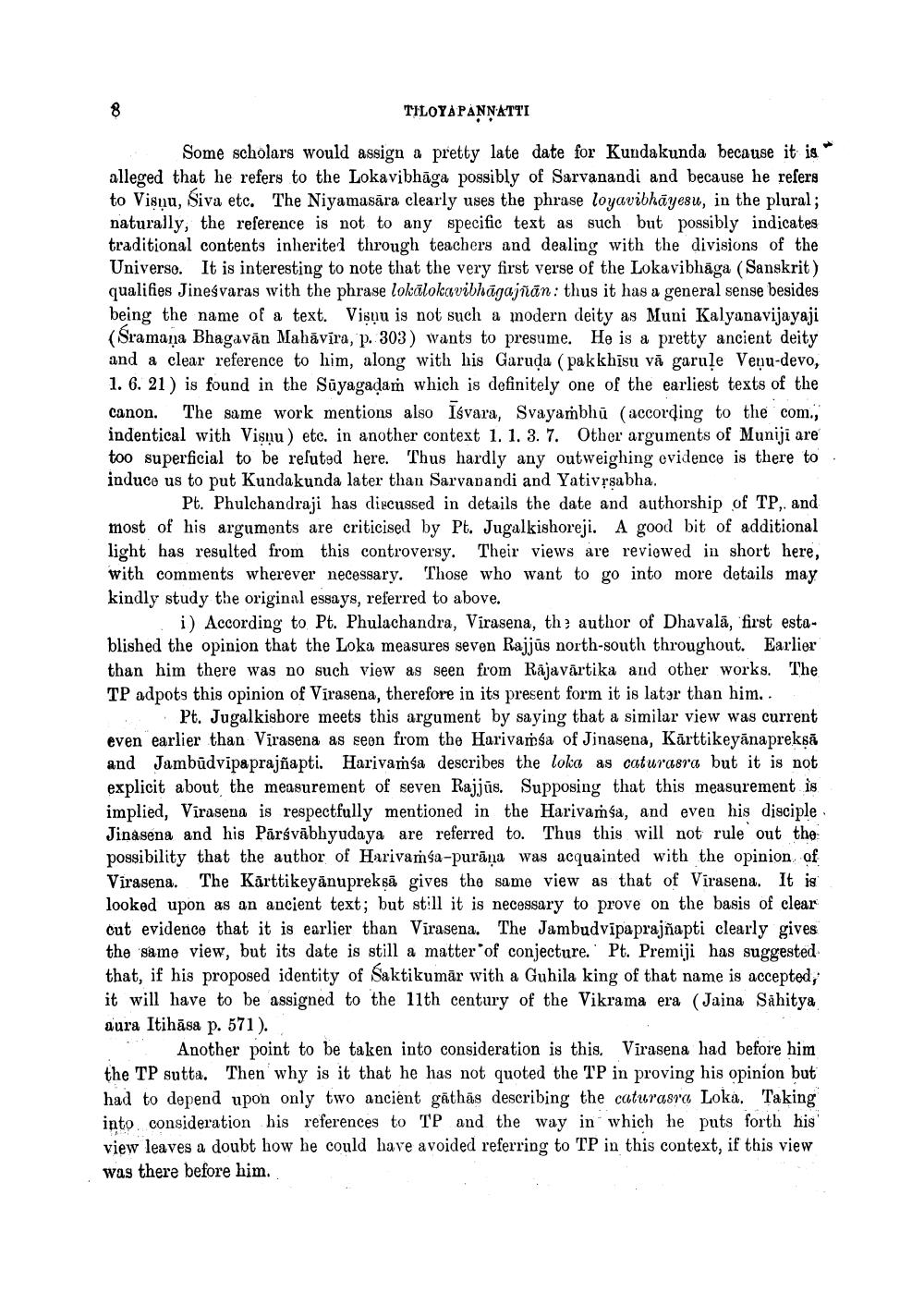Book Title: Introduction Tiloya Pannatti Author(s): A N Upadhye Publisher: A N Upadhye View full book textPage 8
________________ TILOYAPANNATTI Some scholars would assign a pretty late date for Kundakunda because it is alleged that he refers to the Lokavibhāga possibly of Sarvanandi and because he refers to Visuu, Siva etc. The Niyamasāra clearly uses the phrase loyavibhāyesu, in the plural; naturally, the reference is not to any specific text as such but possibly indicates traditional contents inherited through teachers and dealing with the divisions of the Universe. It is interesting to note that the very first verse of the Lokavibhāga (Sanskrit) qualifies Jineśvaras with the phrase lokalokavibhāgajñān: thus it has a general sense besides being the name of a text. Visuu is not such a modern deity as Muni Kalyanavijayaji (Sramana Bhagavān Mahāvīra, p. 303) wants to presume. He is a pretty ancient deity and a clear reference to him, along with his Garuda ( pakkhīsu vā garule Veņu-devo, 1. 6. 21) is found in the Sūyagadam which is definitely one of the earliest texts of the canon. The same work mentions also īśvara, Svayambhū (according to the com., indentical with Visņu) etc. in another context 1. 1. 3. 7. Other arguments of Muniji are too superficial to be reluted here. Thus hardly any outweighing evidence is there to induce us to put Kundakunda later than Sarvanandi and Yativșsabha. Pt. Phulchandraji has discussed in details the date and authorship of TP, and most of his arguments are criticised by Pt. Jugalkishoreji. A good bit of additional light has resulted from this controversy. Their views are reviewed in short here, with comments wherever necessary. Those who want to go into more details may kindly study the original essays, referred to above. i) According to Pt. Phulachandra, Virasena, th: author of Dhavalā, first established the opinion that the Loka measures seven Rajjūs north-south throughout. Earlier than him there was no such view as seen from Rājavārtika and other works. The TP adpots this opinion of Virasena, therefore in its present form it is latar than him.. Pt. Jugalkishore meets this argument by saying that a similar view was current even earlier than Virasena as seen from the Harivamsa of Jinasena, Kārttikeyānapreksā and Jambūdvipa prajñapti. Harivaṁsa describes the loka as caturasra but it is not explicit about the measurement of seven Rajjūs. Supposing that this measurement is implied, Virasena is respectfully mentioned in the Harivaṁsa, and even his disciple Jinasena and his Pārsvābhyudaya are referred to. Thus this will not rule out the possibility that the author of Harivamsa-purāna was acquainted with the opinion of Virasena. The Kárttikeyānupreksā gives the same view as that of Virasena. It is looked upon as an ancient text; but st:ll it is necessary to prove on the basis of clear cut evidence that it is earlier than Virasena. The Jambudvīpaprajñapti clearly gives the same view, but its date is still a matter of conjecture.' Pt. Premiji has suggested that, if his proposed identity of Saktikumār with a Guhila king of that name is accepted, it will have to be assigned to the 11th century of the Vikrama era (Jaina Sahitya aura Itihāsa p. 571 ). Another point to be taken into consideration is this. Virasena had before him the TP sutta. Then why is it that he has not quoted the TP in proving his opinion but had to depend upon only two ancient gathās describing the caturasra Loka. Taking into consideration his references to TP and the way in which he puts forth his view leaves a doubt how he could have avoided referring to TP in this context, if this view was there before him.Page Navigation
1 ... 6 7 8 9 10 11 12 13
